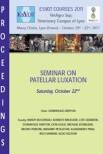Objective: The aim of this study was to describe partial parasagittal patellectomy for the surgical management of patellar luxation, including surgical technique, proposed indications, complications, and outcomes in a cohort of dogs.
Study design: This is a single-center retrospective clinical case series.
Methods: Medical records (2019-2020) of dogs presenting for patellar luxation were reviewed. Clinical signs, luxation direction and grade, preoperative imaging and intraoperative findings, and complications were retrospectively retrieved. Owners were contacted via questionnaire for medium- and long-term follow-up.
Results: A total of 24 stifles in 19 dogs met the inclusion criteria. Intraoperative minor complications occurred in four stifles. A single minor complication occurred postoperatively with no major complications. Increased thickness and radiographic attenuation of the patellar ligament were noted in 14 stifles at radiographic reassessment. Re-luxation was not encountered, with long-term owner-assessed outcome as good to excellent in all cases.
Conclusion: Partial parasagittal patellectomy, used in conjunction with block recession trochleoplasty and tibial tuberosity transposition, provided reliable resolution of patellar luxation in canine stifles with grade 2 or 3 luxation where width mismatch between the patella and the trochlea was noted intraoperatively. Long-term outcome appears to be good to excellent with a low rate of complication.









